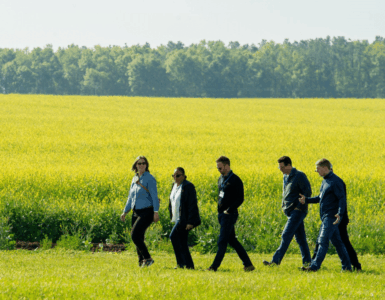Australia is famous for being a major exporter of beef, wheat, wool – but we’ve been on the hunt for farmers who have bucked that trend in favour of something more exotic!
Australia’s farmers produce enough food to feed 80 million people.
We do the bulk of this heavy lifting with our major commodities, such as grains, oilseeds, meat, sugar, cotton, wool, dairy and horticulture.
But what about speciality crops? No, we’re not talking about anything illegal! We’re talking about left of field crops that can return real dollars! Here are a few we found at AustralianFarmers.
1. Lavender
Interest in growing lavender in Australia has increased significantly over the last 5 years. There are now plantings in all States with the most interest in Victoria and southern New South Wales.
The majority of lavender plantings are for craft and aromatherapy applications and can be found in tea rooms, bed and breakfast operations or open gardens and nurseries. The main use for lavender by these growers is dried flowers, followed by fresh flowers and then oil production. Other products include lavender honey, lavender based body care products and therapeutic formulations containing lavender oil.
The variation in scale of oil production operations is considerable with the majority of lavender growersproducing less than 10 kg of oil per annum, approximately 50 – 60 growers. At the other end of the scale is the operation of Bridestowe Estate in Tasmania producing 1200 kg of oil per annum.
Compared to most other agricultural crops lavender can provide an excellent return from a small area with the best lavender returns coming from agri-tourism.

Hepburn Springs near Daylesford in Central Victoria, is the perfect place for a lavender farm. Once a city girl, Carol White saw an auction sign 20 years ago that would change her life. Shepdale was a 100-acre property built around three beautiful but derelict 1860s Italian-built golden stone buildings. Carol painstakingly renovated Shepdale’s buildings, planted a kitchen garden and considered her options.
I loved the Swiss-Italian heritage and culture, and had seen lavender grown commercially in France. My fate was sealed.
The outcome is Lavandula Swiss Italian Farm, named after the botanic name for lavender, which now grows lavender, olives and grapes, all harvested and processed for use on the property. Lavandula is now a major tourist attraction.
Carol told the ABC’s Gardening Australia what inspired her to take the leap.
”I needed income and flexibility to look after my sons, so I set about researching production options. I loved the Swiss-Italian heritage and culture, and had seen lavender grown commercially in France. My fate was sealed.”
2. Ginseng
With the rapidly expanding use of medicinal herbs world-wide, Australia has recognised the opportunity to become an international supplier of many medicinal herbs. The growth in ginseng trading has led to the establishment of an Australian industry based on the growing of American ginseng.
Ginseng has many traditional Chinese medicinal applications such as a nourishing stimulant, immune booster, muscle relaxant and is also used in the treatment of stress.
While the industry is still in its infancy Australia is agriculturally well positioned to capture a share of the world market and cropping is now conducted in a wide range of regions across the eastern and southern States.
The north-west area of Tasmania, near Deloraine, is an area that’s known for its incredibly fertile soil and one region where ginseng is grown. Tasmanian farmer Ziggy Pyka has spent the last 14 years unlocking the secret of how to grow it organically on his bush block, 41° South Tasmania.
Inspired by the amazing health benefits of ginseng he settled in Tasmania to begin the patient task of growing this exotic herb. Many years were spent clearing, building and experimenting with tree growth and mulching methods for our small but growing ginseng crop. It was done the hard way with little help or advice, as ginseng growing in Australia was at the time (and still is) a very young industry.
People don’t realise how long the plants take to grow – two years just for the seeds to germinate, and then four to six years for the plants to mature.
Ziggy outlined his journey, speaking with SBS.
“The first four years it didn’t work. I couldn’t get it growing. But because the sun in Tasmania is strong you need more shade cover. More than half an hour of sun through the day will kill the plant.
“People don’t realise how long the plants take to grow – two years just for the seeds to germinate, and then four to six years for the plants to mature,” Ziggy says.
Ziggy admits that commercial success has been a long journey but what’s important is staying true to his passion. He also reckons it’s important to be a little bit crazy.

3. Saffron
Saffron is the dried stigmas (the female reproductive parts) of the saffron crocus (Crocus sativus). Each crocus flower has three stigmas, and each stigma must be handpicked to maintain the stigma’s integrity.
Traditionally, saffron has three main uses: as a dye, as a spice for cooking and as a powerful medicinal tool.
Saffron is the world most expensive spice because it is an extremely labour-intensive crop. For example, to extract 1kg of saffron from crocuses, the stigmas of almost a quarter of a million flowers must be hand-picked, dried and bottled. Saffron prices at wholesale and retail rates range from US$1,100–11,000/kg.
Iran is the world’s biggest producer and exporter of saffron. Other producers of saffron are Spain, India, Greece, Azerbaijan, Morocco, and Italy.
Here in Australia, Tas-Saff have risen to become the most successful saffron producers in Australia. Terry and Nicky Noonan arrived in Tasmania from Sydney, having sensed the opportunity of replacing imported produce with home grown saffron. They were the first people to bring Crocus Sativus corms (bulbs) to Australia.
The key [if the business was to succeed] was that the saffron had to be top grade.
The Noonan’s home-based business, located in Glaziers Bay in southern Tasmania, co-ordinates the sole network of Saffron growers in Australia. There are currently 60 growers in the network here and in New Zealand.
“The key [if the business was to succeed] was that the saffron had to be top grade,” said Nicky Noonan, speaking with Grow Your Business.
Tas-Saff produces extra category one saffron under the International Organisation of Standardisation. The business is working with the University of Tasmania, the research being funded by AgriFutures (previously the Rural Industries Research and Development Corporation), to ensure quality remains the best it can be.








































Add comment